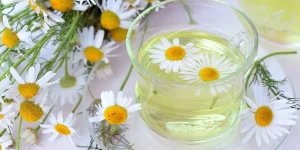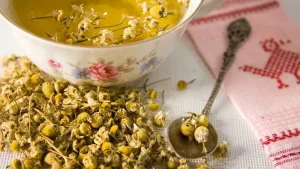
Effective powers of chamomile. In addition to helping with digestion, lowering tension and anxiety, and soothing skin irritation, chamomile is well-known for its potent anti-inflammatory, antioxidant, and relaxing qualities. In addition, it can help regulate blood sugar, promote heart health, and has long been used for dental cleanliness and wound healing. Because of its skin-soothing qualities, chamomile can be applied topically as an oil or in skincare products. It can also be taken internally as a tea or extract.
EFFECTIVE POWERS OF CHAMOMILE
Chamomile, with its delicate daisy-like flowers and subtle fragrance. It has been cherished for centuries for its remarkable medicinal properties and calming effects. This unassuming herb, belonging to the Asteraceae family, holds a revered place in traditional medicine practices worldwide, from ancient Egypt to modern-day holistic healing. Let’s delve into the soothing powers of chamomile and uncover its diverse applications and benefits.
A Brief Overview;
It encompasses two main species: German chamomile and Roman chamomile. Both varieties share similar therapeutic properties, although they differ slightly in appearance and growing conditions. That of the German is an annual plant with small, white flowers and is commonly used in herbal teas, while Roman chamomile is a perennial plant with larger, daisy-like flowers and is often utilized in essential oils and aromatherapy.
Health Benefits;
1. Promotes Relaxation

Due to its well-known relaxing qualities, chamomile is a popular option for easing tension, lowering anxiety, and encouraging relaxation. Its somewhat sedative effects are ascribed to substances such as apigenin, which bind to brain receptors to create a calming sensation.
2. Aids Digestion

EFFECTIVE POWERS OF CHAMOMILE
Chamomile tea is frequently consumed to alleviate digestive discomfort, including bloating, gas, and indigestion. Its anti-inflammatory and anti-spasmodic properties help soothe the gastrointestinal tract and promote healthy digestion.
3. Supports Sleep
Sipping on a warm cup of chamomile tea before bedtime is a cherished bedtime ritual for many. Its calming effects not only ease stress and anxiety but also promote restful sleep. Chamomile’s ability to enhance sleep quality is particularly beneficial for those struggling with insomnia or irregular sleep patterns.
4. Relieves Skin Irritations

EFFECTIVE POWERS OF CHAMOMILE
Chamomile’s anti-inflammatory and anti-bacterial properties make it a popular remedy for various skin conditions, including eczema, psoriasis, and acne. Applying chamomile-infused creams or lotions can help reduce inflammation, soothe irritation, and promote healing.
5. Boosts Immunity
Rich in antioxidants, It helps strengthen the body’s natural defenses against infections and illnesses. Regular consumption of chamomile tea or supplements may contribute to overall immune health and resilience
Usage and Precautions

EFFECTIVE POWERS OF CHAMOMILE
Chamomile can be enjoyed in various forms, including teas, tinctures, essential oils, and topical ointments. While generally considered safe for most people, individuals with allergies to plants in the Asteraceae family (such as ragweed or marigolds) should exercise caution when using it, as allergic reactions may occur. Additionally, pregnant women and those taking certain medications should consult with a healthcare professional before incorporating chamomile into their routine.
Summary
Chamomile’s gentle yet potent healing properties have earned it a revered status in the world of natural medicine. Whether sipped as a soothing tea, applied topically to the skin, or diffused into the air for aromatherapy. It offers a myriad of health benefits for both the body and mind. Embracing this ancient herbal remedy can lead to a greater sense of well-being and harmony in our daily lives. Connecting us more deeply with the healing power of nature.